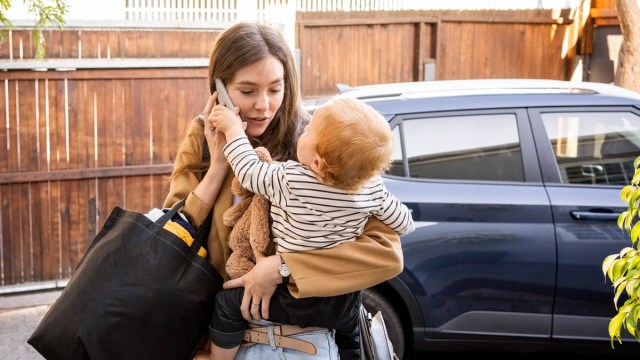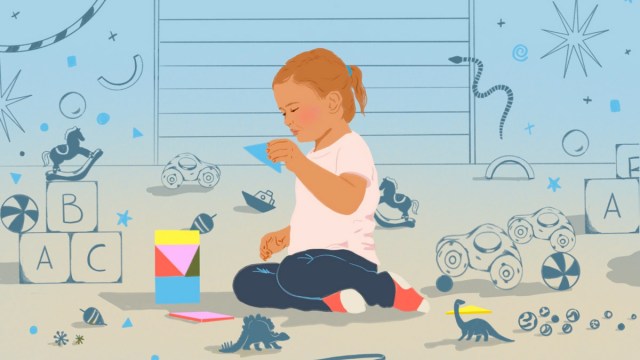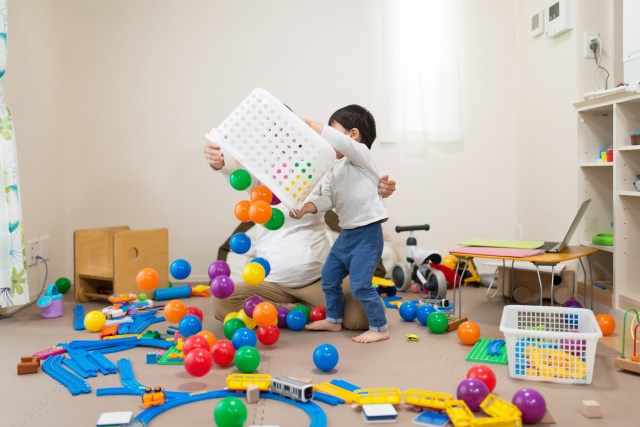You don’t have to do it all. Not only is that okay, but it’s healthy
You’ve got a fridge papered with to-do lists and an epic bookmark backlog of work-life balance articles. But, let’s be real: Something’s gotta give. And first on the chopping block should be that tired old trope that you, working mom, can have it all. Ya can’t. But there’s no shame in accepting this. Because you can easily kill it at this mom life/work life thing by ditching unnecessary stressors. Think of it as Marie Kondo-ing your life. Here are 13 ideas about what working moms give up to help them stay sane.
1) Scratch-made meals. every. single. night.
While family dinner is great for kids, and we’re all gaga over the idealized concept of the home-cooked meal, we’re all about the cheats. Consider a healthy meal-delivery service, buy a bag of pre-made pasta and stir in some veggies, or get your takeout on.
2) Chasing a perfect 50/50 family/work split.
Some weeks your family will need more attention. And others, you’ve got to play it like Sandberg and lean in at work. The trick (basic but effective) is communication—tell your partner if they need to step up and be honest with your boss about your sick kiddo at home.
3) Work happy hours.
Sure, you can go big at important events like holiday parties. But watching Ben from IT perfect his “Friends in Low Places” game at karaoke every Friday night isn’t going to make a difference come annual review time. Kick it at home with a glass of wine or some family-friendly mocktails instead.
4) Being a DIY goddess.
Bakesale? Store-bought cookies. Party favors? Etsy. Done and done. And even Halloween costumes can be hacked: hot glue, not sewing; hitting the thrift store, not the craft store. (But if DIY is your thing? By all means, keep it up, Martha!)
5) That social-media addiction.

Life’s little moments don’t all need Facebook documentation, and studies show that scrolling through endless feeds of life presented as perfect (when it never is) leads to a major self-doubt spiral. Designate a time to catch up—say 9-9:30 p.m. And if you still find yourself scrolling during the day, try switching your phone’s color settings to grayscale, which makes it a lot less appealing, or take your social apps off of your home screens so they’re more tedious to find.
6) Making it to every practice and every rehearsal.
Be there for your kids when it matters—at the big game or on opening night. But it’s perfectly fine to tag-team chauffeur duty with a mom-friend. And if your pal is a SAHM who picks up your slack during the week, let her kids hang out at your place some weekends to give her a break.
7) Saying “yes” to every friend invite.
Real talk: Friend time is one of the first things to go when you have littles. And while losing your social life completely is a no-no—consider re-evaluating your friendships. Prioritize those who infuse you with energy and joy. And cut out anyone who leaves you drained.
8) Doing everything for your kids.
Little guys can be more self-sufficient than we give them credit for! Assign them basic tasks like folding towels or watering plants. And, as they get older, graduate them to making their own simple lunches, dusting, and dishwasher duty.
9) Giving up your house to your children (and their stuff).
Toy creep—it’s a problem. When kid stuff is strewn all over the place, it means more picking up for you and dad. Limit their toys to a single room. Or, at least, designate toy-free zones like your bedroom and the primary bath.
10) Overcommitting.
Three birthday parties in one weekend? Just no. Keeping up with the scheduling of parties and playdates is hard enough, let alone the driving, hosting, baking, and present-buying (not to mention the, ahem, cost). Declining some invites = less stress and more family time.
11) Getting up with your kids every night.
When they holler “Mommmm,” it’s A-OK if dad comes to the rescue. And while an every-other-night deal with the hubs might be unrealistic, prioritize who does the calming based on what you each have on tap the next day.
12) That idea of the “perfect” work persona.
While setting boundaries might seem scary, you’ll find that your coworkers will come to respect them—whether it’s no meetings after five or no emails on weekends. Consistency is key. And if you’re hourly, let it be known (politely) that your hours are firm, and no, you can’t cover for your slacker co-worker who’s MIA again. Standing your ground—while otherwise crushing it at your job—is one way to reshape the workplace for working moms.
13) Stalling on switching jobs.
Despite giving it your best shot, sometimes your company just isn’t (and will never be) parent-friendly. In this case, it’s time to bust out the ole resume and start your job hunt. And don’t feel bad about it! Put out feelers with working-mom friends because they’ll have your back. And for part-time work, do a little research. There are great companies out there (like us at Alice’s Table!) that let you make your own schedules, or that offer benefits packages even to part-time workers (Starbucks, Whole Foods, Home Depot).
And as for what you should never give up—ever? “Me” time (even if you’ve got to schedule it in), “us” time (even if it’s just Netflix and chill), and time to breathe. You’ve got this!






























